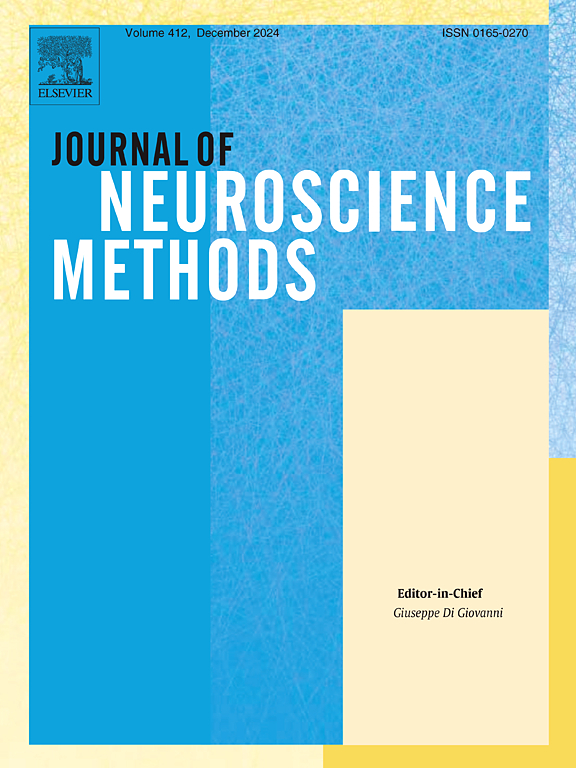基于梯度的脑白质纤维几何分析新方法。
IF 2.3
4区 医学
Q2 BIOCHEMICAL RESEARCH METHODS
引用次数: 0
摘要
背景:精确的脑纤维通路几何和形态计量学分析对于揭示大脑组织和正常和病理脑功能背后的机制至关重要。然而,现有的白质(WM)纤维几何分析方法仍然有限。新方法:提出了一种新的大规模梯度特征(LsGF)度量来量化沿光纤流线的切线方向变化率。利用类内相关系数(ICC),在流线计数和示踪算法两个关键因素下,系统评价了LsGF图谱的稳定性。然后应用LsGF研究WM形态的性别差异,通过比较LsGF图谱和纤维长度图谱来评估敏感性。结果显示,LsGF对流线计数的变化表现出显著的稳健性(99%的icc > 0.8),但对导管造影算法表现出显著的依赖性(不到60%的icc > 0.6)。将LsGF方法应用于性别二态性分析,发现主要在丘脑、内囊、小脑、胼胝体、舌回、梭状回、楔前叶、直回、眼窝额叶皮质、扣带回皮质、胼胝体和嗅觉区域存在明显的几何模式。与现有方法的比较分析表明,LsGF在检测微观结构几何复杂性方面优于纤维长度度量,而后者更有效地表征宏观结构特征。这些发现强调了LsGF和纤维长度度量在WM分析中的互补价值。结论:LsGF图谱能够对整个大脑的定量流线指标进行体素分析,强调了一致的神经束造影方法对可靠结果的必要性。本文章由计算机程序翻译,如有差异,请以英文原文为准。
A new gradient-based method for analyzing brain white matter fiber geometry
Background
Precise geometric and morphometric analyses of brain fiber pathways are crucial for unraveling brain organization and mechanisms underlying normal and pathological brain functions. However, existing methods for white matter (WM) fiber geometry analysis remain limited.
New method
We propose a novel Large-scale Gradient Feature (LsGF) metric to quantify the tangent direction change rate along fiber streamlines. Using intra-class correlation coefficients (ICC), we systematically evaluated the stability of LsGF maps under two key factors: streamline count and tractography algorithm. LsGF was then applied to investigate gender disparities in WM morphology, with sensitivity assessed by comparing LsGF maps against fiber length maps.
Results
Results showed that LsGF exhibited remarkable robustness to variations in streamline count (99 % of ICCs > 0.8), but demonstrated significant dependency on tractography algorithm (less than 60 % of ICCs > 0.6). Application of the LsGF method to gender dimorphism analysis uncovered distinct geometric patterns primarily in the thalamus, internal capsule, cerebellum, corpus callosum, lingual gyrus, fusiform gyrus, precuneus, gyrus rectus, orbitofrontal cortex, cingulate cortex, calcarine, and olfactory regions.
Comparison with existing methods
Comparative analysis indicated that LsGF outperformed fiber length metrics in detecting microstructural geometric complexity, whereas the latter more effectively characterized macroscale architecture features. These findings underscore the complementary value of LsGF and fiber length metric in WM analysis.
Conclusions
The LsGF map enables voxel-wise analysis of quantitative streamline metrics across the whole brain, highlighting the necessity of consistent tractography methods for reliable results.
求助全文
通过发布文献求助,成功后即可免费获取论文全文。
去求助
来源期刊

Journal of Neuroscience Methods
医学-神经科学
CiteScore
7.10
自引率
3.30%
发文量
226
审稿时长
52 days
期刊介绍:
The Journal of Neuroscience Methods publishes papers that describe new methods that are specifically for neuroscience research conducted in invertebrates, vertebrates or in man. Major methodological improvements or important refinements of established neuroscience methods are also considered for publication. The Journal''s Scope includes all aspects of contemporary neuroscience research, including anatomical, behavioural, biochemical, cellular, computational, molecular, invasive and non-invasive imaging, optogenetic, and physiological research investigations.
 求助内容:
求助内容: 应助结果提醒方式:
应助结果提醒方式:


